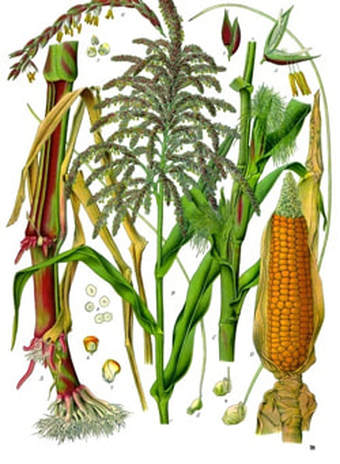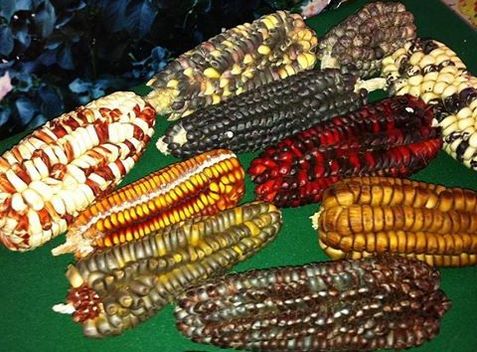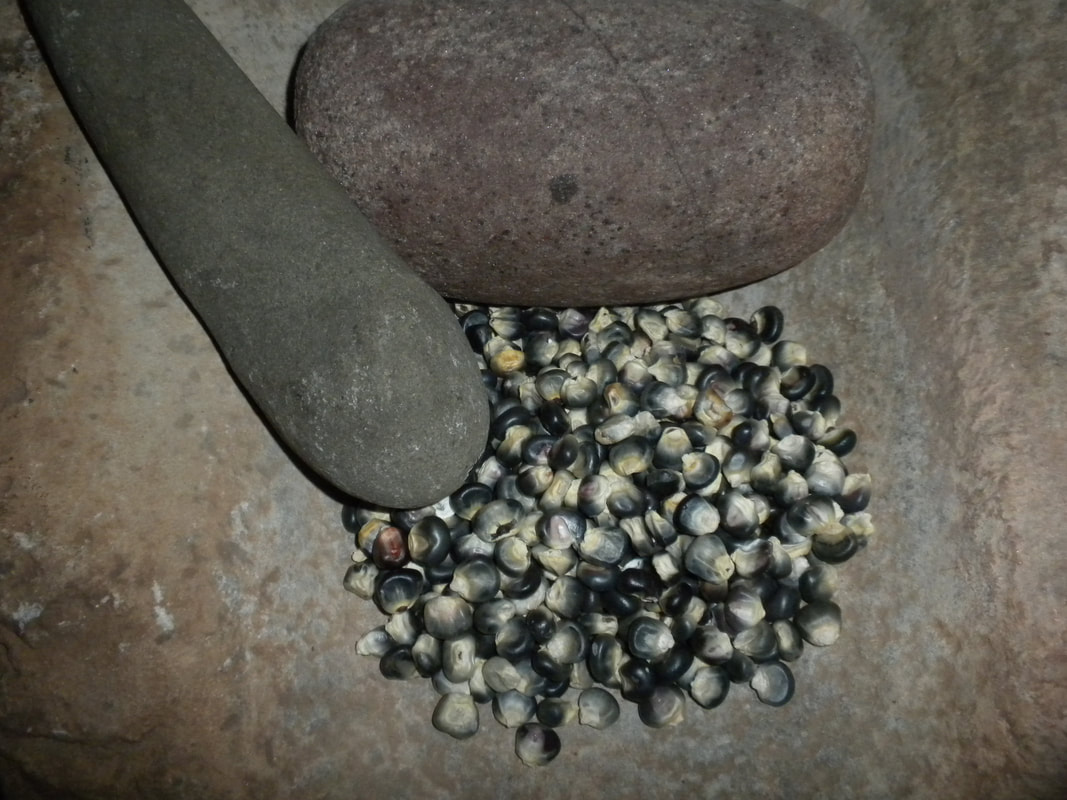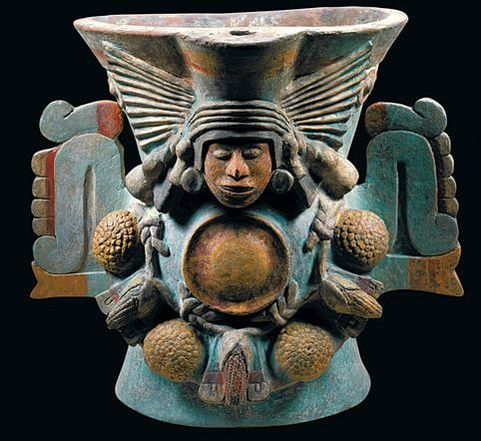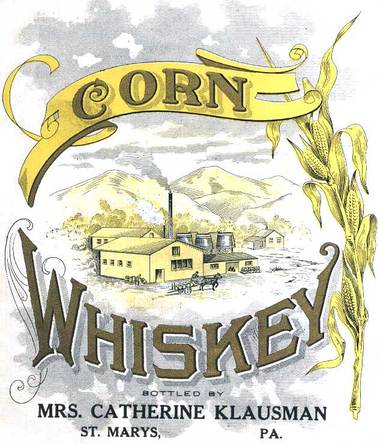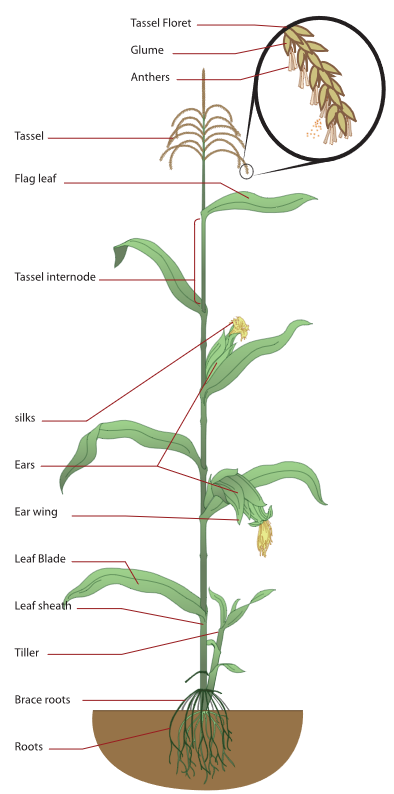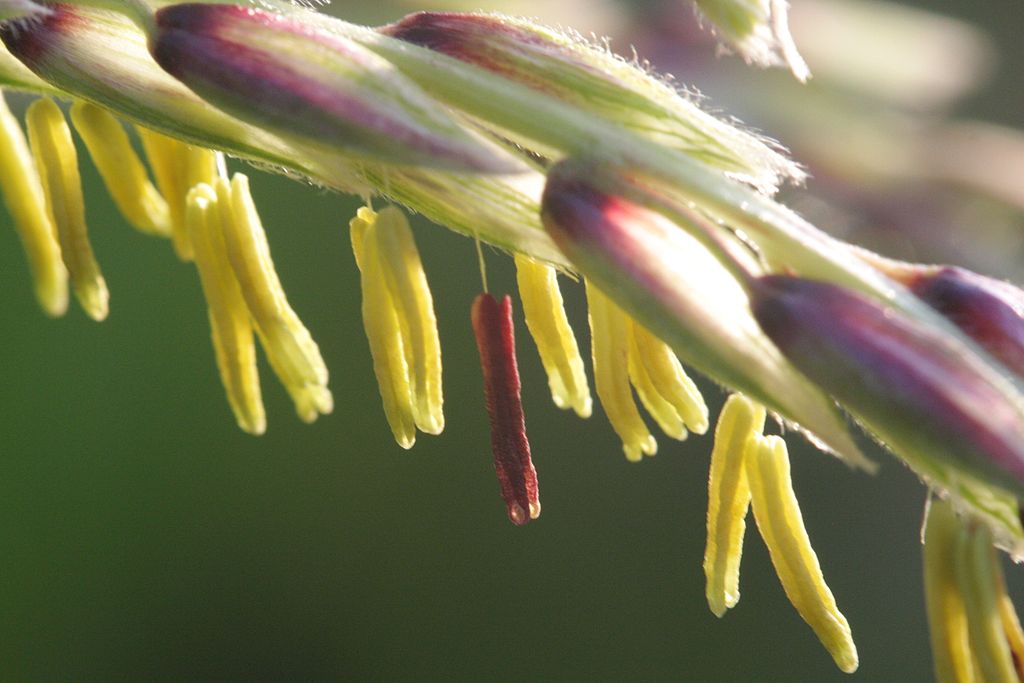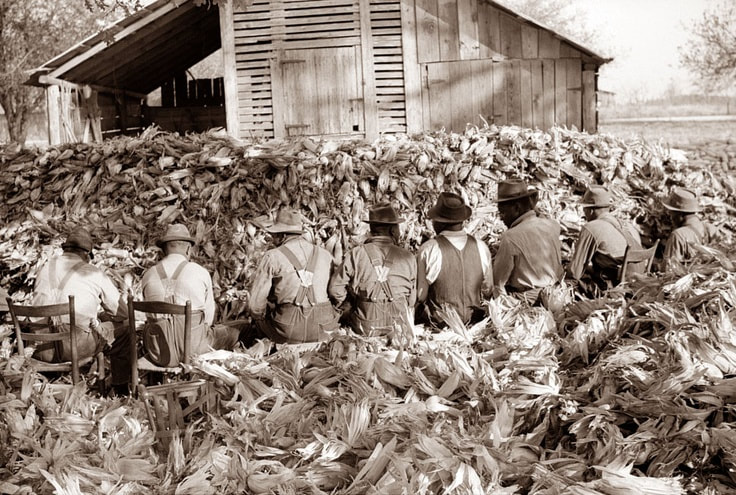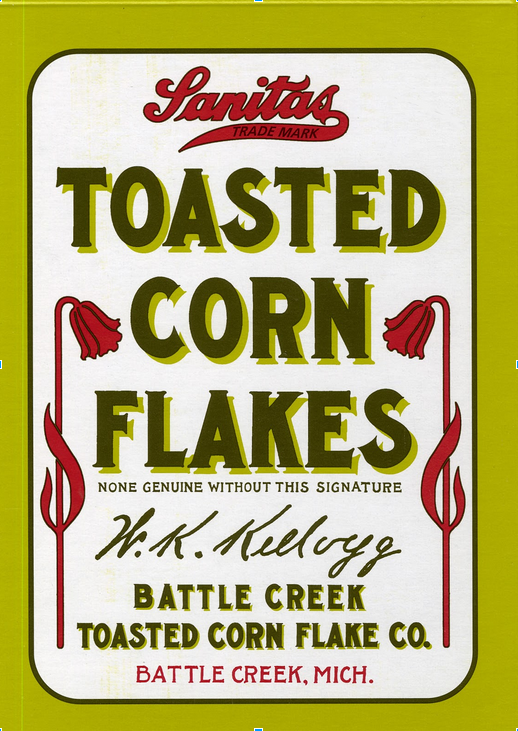Corn, Maize: History, Lore and Growing Information:
Corn Photo Gallery 1:
Ancient Corn History:
Scholars now believe that the Balsas Valley area of south-central Mexico was the center of corn domestication some 9-10,000 years ago. Starting with short, thinly stalked plants bearing only one seed pod, the ancient Maya and Olmec civilizations saved seed from the best plants and slowly bred their corn over time into bigger and better plants. The original Maize may have been cross bred with a native grain called teosinte until the plants became taller, thicker and more productive. Now there are literally hundreds of different strains of maize. Columbus brought corn seeds back to Europe from Central America just before 1700 AD (Columbus actually never discovered nor set foot upon any part of North America in his four voyages). Over 5,000 years ago, ancient *Minoan ships likely brought North American corn back to the Mediterranean, where it migrated to Asia and became the high-gluten strain known as Asian waxy corn. The dried silk of corn is used medicinally for urinary problems.
On Growing Corn:
Corn is best planted in a block of at least three rows, with rows two feet apart. Planting in this manner assists in pollination and development of full ears. Make the furrows about four inches deep, sprinkle composted chicken manure or another high nitrogen fertilizer in the bottom of the furrow, drop the corn seeds (one every six inches or so) into the furrow, then cover with soil and tamp down by hand. Water thoroughly after planting, but then hold off on the water until the corn shows above the ground. Hot, sunny, dry days provide the best conditions for germination, and a hard crust on the surface makes it difficult for crows to pull up the young seedlings. After the seedlings reach three inches or so, thin them to at least a foot apart, and cultivate frequently and shallowly, pushing soil up around the plants as they mature (in order to give them more wind resistance). When the corn tassels appear, extra water is required.
Once the corn plants reach knee high, you can companion plant with squash, crimson clover, and/or pole beans. (Native Americans typically planted the "Three Sisters" of basic food: corn, beans and squash, all together in one cultivated field). When the clover or squash comes up, it covers up the bare soil and discourages weeds. The roots of any legumes, such as clover or beans, fix airborne nitrogen, which is then added to the soil and consumed by the corn. Corn needs a high amount of nitrogen and is a heavy feeder, therefore, active soil management is needed to keep soils fertile when growing long term. Composted manure, blood meal, feather meal and leather meal are all great natural sources of nitrogen, although vegans may not approve or even be aware of nitrogen sources used on organic farms. Fresh manure, especially chicken, may burn plants, so never use it raw. (Never use manure from any animal that eats meat.) Nearly ALL the natural sources of nitrogen come from animals. Human urine is high in nitrogen (uric acid) and can be used fresh IF mixed 20 to 1 with water. Fresh undiluted urine will overdose plants and may kill them (as witnessed by all the brown spots in your lawn left by the neighbor's dog pee), however, it is useful to pee into your compost bin on a regular basis. Wood ash can be added to soil topside just before the stalks mature, adding potassium from the NPK for best blooming.
Separate all corn varieties by 600 feet if growing for seed stock.
Harvesting & Eating Corn:
Harvest sweet corn when the silk just starts to dry/turn and the kernels are still full and juicy. Get the fire going under a big kettle of water before you even harvest heirloom sweet ears, then pick them and drop the fresh corn into the boiling water without delay. This will give you the sweetest corn, because sugars rapidly become starch once the corn is harvested.
To make parched corn (very good for winter soups), parboil the fresh ears for two minutes and then put in cold water and then dry in a dehydrator or in the sun. Once the kernels are dry on the cob, shuck them off and make sure they are completely dried through before storing in gallon jars for the winter. This is very similar to the method for freezing corn.
To freeze, parboil the fresh corn ear for two minutes, dump in cold water to cool, then slice the kernels off the ear with a knife and put them in plastic bags and freeze them right away--that works really well, and these can be taken out of the freezer and reconstituted by boiling in a little water and butter or coconut oil--yummy!
Some corns are best for roasting corn. These are usually a dense sweet or light dent corn with harder shells that require a longer cooking time. Roast over a BBQ or open fire and garnish with butter and salt and pepper. Yummy!
To save the seed for replanting, obviously, do not cook it! Let the ears fully mature on the stalks; then pick, shuck and dry ears on screens in a place with good airflow. When the seed is completely dry, remove the kernels and store in glass Mason jars for use the next year, or the year after.
Corn Varieties:
Indian corn is also known as Flint corn or Calico corn. Indian corn is often dried and used to make corn flour and hominy. Because each corn kernel has a hard outer shell when dry, it was likened to being 'hard as flint'; hence the name. Flint is an extremely hard stone known to many ancient peoples as a fire starter and sparking tool. It was so effective that the standard 'Flintlock' guns used from about 1600-1800 AD actually had a piece of flint on the striker, which would hit a metal strike plate on the gun, igniting the gunpowder in the gun at a time when gunpowder was still carried in a flask or converted cow horn, before bullets were invented.
Dent Corn is similar to flint corn, but is more a heritage from white settlers and small scale farmers in the USA. It was so named due to the dent that develops in the corn top after drying. Dent corn is dried and ground into corn meal, flour or masa. Dent corn is often grown for silage. Many dent corns were refined or cross-bred from original Indian corns centuries ago.
Asian Sweet Corn was originally from the Americas, but it traveled to Europe many millennia before America was 'discovered' by Columbus in 1492. About 5,000 years ago, *Minoan ships from the islands of Crete and Atlantis brought Native American corn to the edges of Asia. Since the ancient Minoan sailors were surface mining our Great Lakes copper over five millennia ago to fuel the European Bronze Age, removing from one million to one billion pounds of copper ore, they are the most likely candidates for whomever actually brought corn seeds and coca powder to the Mediterranean around 2-3000 BC. (We know this because an underwater Minoan shipwreck was filled with copper that metallurgical tests matched to the unique signature of the Michigan copper deposits that still are being worked today. And since scientists reported that South American coca powder had been injected into an ancient Egyptian mummy, we know that ancient Minoan sailors were also transporting dried coca leaves to the Mediterranean about 5,000 years ago. The three New World C's: copper, coca & corn.) Those imported/exported American corn seeds eventually evolved naturally over many millennia into the waxy, high-gluten corn strain now found all over Asia.
Many millennia later, Asian waxy corn was newly 'discovered' by an American botanist in China in 1909. This strange plant showed several peculiar traits when later analyzed by western scientists. In 1922, a researcher found that the endosperm of waxy maize contained only amylopectin and no amylose starch molecules, in opposition to American maize varieties that contain both starches. Until 1941, the main source of starch in the USA was tapioca from Japan, but during WWII, food processors were forced to turn to waxy maize for starch production. Amylopectin or waxy starch is used mainly in food products, as well as in the textile, adhesive, corrugating and paper industry.
When feeding trials later showed that waxy maize could produce more efficient weight gains in cattle than normal dent maize, interest in waxy maize suddenly mushroomed. Waxy maize fields yield about 3.5% less per acre than their other corn cousins.
Geneticists have shown that waxy maize has an abnormal difference in metabolism precluding the synthesis of amylose in the endosperm. It is coded by a single recessive gene (wx).
Asian sweet corn must be cooked for at least 30 minutes. When dried, Asian corn does not shrink, shrivel or dent. It is so dense that is doesn't dent.
-------->END of the Corn Lore...
but,
...more lore is lurking lower...
Scholars now believe that the Balsas Valley area of south-central Mexico was the center of corn domestication some 9-10,000 years ago. Starting with short, thinly stalked plants bearing only one seed pod, the ancient Maya and Olmec civilizations saved seed from the best plants and slowly bred their corn over time into bigger and better plants. The original Maize may have been cross bred with a native grain called teosinte until the plants became taller, thicker and more productive. Now there are literally hundreds of different strains of maize. Columbus brought corn seeds back to Europe from Central America just before 1700 AD (Columbus actually never discovered nor set foot upon any part of North America in his four voyages). Over 5,000 years ago, ancient *Minoan ships likely brought North American corn back to the Mediterranean, where it migrated to Asia and became the high-gluten strain known as Asian waxy corn. The dried silk of corn is used medicinally for urinary problems.
On Growing Corn:
Corn is best planted in a block of at least three rows, with rows two feet apart. Planting in this manner assists in pollination and development of full ears. Make the furrows about four inches deep, sprinkle composted chicken manure or another high nitrogen fertilizer in the bottom of the furrow, drop the corn seeds (one every six inches or so) into the furrow, then cover with soil and tamp down by hand. Water thoroughly after planting, but then hold off on the water until the corn shows above the ground. Hot, sunny, dry days provide the best conditions for germination, and a hard crust on the surface makes it difficult for crows to pull up the young seedlings. After the seedlings reach three inches or so, thin them to at least a foot apart, and cultivate frequently and shallowly, pushing soil up around the plants as they mature (in order to give them more wind resistance). When the corn tassels appear, extra water is required.
Once the corn plants reach knee high, you can companion plant with squash, crimson clover, and/or pole beans. (Native Americans typically planted the "Three Sisters" of basic food: corn, beans and squash, all together in one cultivated field). When the clover or squash comes up, it covers up the bare soil and discourages weeds. The roots of any legumes, such as clover or beans, fix airborne nitrogen, which is then added to the soil and consumed by the corn. Corn needs a high amount of nitrogen and is a heavy feeder, therefore, active soil management is needed to keep soils fertile when growing long term. Composted manure, blood meal, feather meal and leather meal are all great natural sources of nitrogen, although vegans may not approve or even be aware of nitrogen sources used on organic farms. Fresh manure, especially chicken, may burn plants, so never use it raw. (Never use manure from any animal that eats meat.) Nearly ALL the natural sources of nitrogen come from animals. Human urine is high in nitrogen (uric acid) and can be used fresh IF mixed 20 to 1 with water. Fresh undiluted urine will overdose plants and may kill them (as witnessed by all the brown spots in your lawn left by the neighbor's dog pee), however, it is useful to pee into your compost bin on a regular basis. Wood ash can be added to soil topside just before the stalks mature, adding potassium from the NPK for best blooming.
Separate all corn varieties by 600 feet if growing for seed stock.
Harvesting & Eating Corn:
Harvest sweet corn when the silk just starts to dry/turn and the kernels are still full and juicy. Get the fire going under a big kettle of water before you even harvest heirloom sweet ears, then pick them and drop the fresh corn into the boiling water without delay. This will give you the sweetest corn, because sugars rapidly become starch once the corn is harvested.
To make parched corn (very good for winter soups), parboil the fresh ears for two minutes and then put in cold water and then dry in a dehydrator or in the sun. Once the kernels are dry on the cob, shuck them off and make sure they are completely dried through before storing in gallon jars for the winter. This is very similar to the method for freezing corn.
To freeze, parboil the fresh corn ear for two minutes, dump in cold water to cool, then slice the kernels off the ear with a knife and put them in plastic bags and freeze them right away--that works really well, and these can be taken out of the freezer and reconstituted by boiling in a little water and butter or coconut oil--yummy!
Some corns are best for roasting corn. These are usually a dense sweet or light dent corn with harder shells that require a longer cooking time. Roast over a BBQ or open fire and garnish with butter and salt and pepper. Yummy!
To save the seed for replanting, obviously, do not cook it! Let the ears fully mature on the stalks; then pick, shuck and dry ears on screens in a place with good airflow. When the seed is completely dry, remove the kernels and store in glass Mason jars for use the next year, or the year after.
Corn Varieties:
- Asian corn (Zea mays var. ??) - A dense, waxy, high gluten strain of corn grown in most of Asia for many centuries. Comes in a rainbow of colors with white, yellow and black the most common.
- Dent corn (Zea mays indentata) (Field corn) - A high starch content; used for flour, cornmeal, masa and full roasting ears. Yellow or white colors; named for the dimple (or dent) in the kernels. Typically from the Midwest and Southwest areas of the USA. Besides providing a food source, dent corn is also used to make plastic and ethanol fuels.
- Flint corn (Zea mays indurata) (Indian corn, Calico corn) - Kernels have a very hard outer layer; low water content, resists freezing more than other varieties, and is multicolored and all yellow. Flint corn is used for hominy, polenta, grits, popping, animal feed, and as an ornamental. Flint corn is often from the Northeast area of the USA.
- Pod corn (Zea mays var.tunicata) - A mutation of early corn; each kernel is surrounded by a husk; multicolored. Hard to find now.
- Popcorn (Zea mays everta) - A subspecies of Flint corn; kernels have a hard outer layer surrounding a soft starchy seed.
- Sweet corn (Zea mays saccarata; Syn. Zea mays rugosa) - Grown for picking early and fresh, before the kernels convert from sugar to starch. Sweet corn has been a staple food of the Americas for many millennia, providing both protein and carbohydrates. Modern F1 hybrid sweet corns are developed for higher sugar content and sugars that do not convert to starch quickly; but their seeds will not grow true if saved. Hybrids are made by hand-pollinating the female ears of one strain with the male tassel sperm of another corn strain, or planting them in alternating rows. These have big consumer appeal, but gardeners wishing to save their own seed and not resupply from monopolistic seed companies each year must grow old-fashioned heirlooms.
Indian corn is also known as Flint corn or Calico corn. Indian corn is often dried and used to make corn flour and hominy. Because each corn kernel has a hard outer shell when dry, it was likened to being 'hard as flint'; hence the name. Flint is an extremely hard stone known to many ancient peoples as a fire starter and sparking tool. It was so effective that the standard 'Flintlock' guns used from about 1600-1800 AD actually had a piece of flint on the striker, which would hit a metal strike plate on the gun, igniting the gunpowder in the gun at a time when gunpowder was still carried in a flask or converted cow horn, before bullets were invented.
Dent Corn is similar to flint corn, but is more a heritage from white settlers and small scale farmers in the USA. It was so named due to the dent that develops in the corn top after drying. Dent corn is dried and ground into corn meal, flour or masa. Dent corn is often grown for silage. Many dent corns were refined or cross-bred from original Indian corns centuries ago.
Asian Sweet Corn was originally from the Americas, but it traveled to Europe many millennia before America was 'discovered' by Columbus in 1492. About 5,000 years ago, *Minoan ships from the islands of Crete and Atlantis brought Native American corn to the edges of Asia. Since the ancient Minoan sailors were surface mining our Great Lakes copper over five millennia ago to fuel the European Bronze Age, removing from one million to one billion pounds of copper ore, they are the most likely candidates for whomever actually brought corn seeds and coca powder to the Mediterranean around 2-3000 BC. (We know this because an underwater Minoan shipwreck was filled with copper that metallurgical tests matched to the unique signature of the Michigan copper deposits that still are being worked today. And since scientists reported that South American coca powder had been injected into an ancient Egyptian mummy, we know that ancient Minoan sailors were also transporting dried coca leaves to the Mediterranean about 5,000 years ago. The three New World C's: copper, coca & corn.) Those imported/exported American corn seeds eventually evolved naturally over many millennia into the waxy, high-gluten corn strain now found all over Asia.
Many millennia later, Asian waxy corn was newly 'discovered' by an American botanist in China in 1909. This strange plant showed several peculiar traits when later analyzed by western scientists. In 1922, a researcher found that the endosperm of waxy maize contained only amylopectin and no amylose starch molecules, in opposition to American maize varieties that contain both starches. Until 1941, the main source of starch in the USA was tapioca from Japan, but during WWII, food processors were forced to turn to waxy maize for starch production. Amylopectin or waxy starch is used mainly in food products, as well as in the textile, adhesive, corrugating and paper industry.
When feeding trials later showed that waxy maize could produce more efficient weight gains in cattle than normal dent maize, interest in waxy maize suddenly mushroomed. Waxy maize fields yield about 3.5% less per acre than their other corn cousins.
Geneticists have shown that waxy maize has an abnormal difference in metabolism precluding the synthesis of amylose in the endosperm. It is coded by a single recessive gene (wx).
Asian sweet corn must be cooked for at least 30 minutes. When dried, Asian corn does not shrink, shrivel or dent. It is so dense that is doesn't dent.
-------->END of the Corn Lore...
but,
...more lore is lurking lower...
* A Shaman's Metaphysical Telling of some of the Secrets of Ancient History:
The ancient Minoans or Atlantians knew of the Americas 5,000 years ago and routinely sailed there to mine the huge reserves of Great Lakes copper that fueled the European Bronze Age. (What we call Minoa, Plato called Atlantis.) They also brought back Indian Corn and Coca leaves to the Mediterranean. They had a very advanced civilization before a huge cataclysm nearly killed them all.
It is commonly--but erroneously--believed that Minoan society was completely wiped out by the massive volcanic explosion that destroyed Santorini island about 1500 BC, creating a huge, deadly tsunami. But, some alternative historians believe the volcanic blast survivors from Crete and Atlantis then merged with the Phoenicians, eventually settling at Alexandria, Damascus and Qumran with their secret knowledge of the New World still intact. Over time they evolved into the highly advanced, metaphysical Jewish sect called the Essenes. (Both John the Baptist and Jesus the Nazarene were Jewish Essenes. Jesus was given the 'Nazarene' moniker by his contemporaries because he was an Essene from the tiny town of Nazareth, or the Nazareth-Essene, shortened to: the Nazarene).
Several boatloads of the mystical Essenes moved to southern France around 30 AD along with their sacred mother Mary Magdalene and the secret bloodline of Christ (Mary was never a prostitute, but was actually an Egyptian High Priestess of Isis who was highly trained in Egyptian Tantra and was a perfectly cosmic spiritual match for Jesus). This secret Essene community that surrounded Mary in Southern France and protected the bloodline of Christ eventually evolved into the Poor Fellow-Soldiers of Christ and the Temple of Solomon, or the Order of Solomon's Temple, now often just called the Knight's Templar. The Essenes turned Templars knew this explosive secret of the Jesus-Mary bloodline or Holy Grail, which is represented by their exclusive use of the hooked X, their many portraits of secret hand signs that show an M for Mary, and statues in their churches that show Mary as either pregnant or holding her child. (Author Dan Brown also figured out this truth, penning a novel that is as much fact as it is fiction.)
Leonardo da Vinci was a Templar and he also knew their most secret of secrets; that is why he put Mary Magdalene next to Jesus in his famous painting of the Last Supper. The Templars original name (Soldiers of Christ and the Temple of Solomon) is a clear mix of both Christianity and Jewish influence on its face, since the First Holy Temple was purely Jewish in heritage and was never a Christian icon. That Temple was literally built by King Solomon, son of King David (who killed the giant Goliath with a slingshot)--King of Judea and all of the 12 tribes of the Jewish people--as their most revered religious site in all history. From about 1000 BC to around 550 BC, the First Holy Temple of Solomon literally held the original tablets from Moses that had the Ten Commandments inscribed upon them. They were stored in a glorious golden box called the Ark of the Covenant. In the inner sanctum of the Temple, known as the Holy of the Holies, the golden Ark was housed and revered by all of Judea. It served as the heart of Jewish worship for nearly half a millennia, until the entire First Holy Temple was destroyed by the invading Babylonians (Jerusalem has been sacked by foreign invaders some 27 times throughout its 3.000+ year old history).
The Second Holy Temple was rebuilt and expanded soon thereafter, but the original Ark was lost to history, perhaps hidden away in the maze of old tunnels (one was said to be 18 miles long) that run under the entire area around Jerusalem (did the Templars find the lost Ark? ...and if so, where is it?? ...or did an Egyptian Queen bring the Ark to the USA with a horde of other gold Egyptian artifacts that were found just outside of Cairo, Ill.???).
In 70 AD, the Roman Army, responding to violent attacks by the Jewish Zealots, completely destroyed the Second Holy Temple during the first Jewish Holocaust, a genocide so intense that it exterminated three of the four existing Jewish sects, eliminated or enslaved the 100,000 Jews in Judea, and murdered all of their priests save just ONE. The Roman-driven holocaust abruptly ended with the mass suicide of the remaining 1,000+ free Jewish men, women and children fighting at the mountain-top fortress of Masada. This destruction of the Jewish people and their Temple left just the Temple Mount and the Western Wall remaining, a most Holy place where the Jewish people continue to worship and cry over the historic destruction of their most precious religious site. This Wailing Wall has been the focus of millions of Jewish prayers and tears (as they wail with grief) over their profound sacred loss for about 2,000 years now. When the invading Muslim hordes first conquered Judea in 637 AD, the Temple Mount came under foreign control once again, lasting about 500 years until the Crusades. At the end of the Crusade period, when the Muslim armies drove out all the Christians and the Knight's Templar, Muslim religious leaders decided to invent a story about Muhammad traveling to Jerusalem and going on his 'Night Flight' (in historic reality, Muhammad never, ever even got close to visiting the Jewish capital; this story is pure fiction, with an evil twist). In doing so, they committed a profound form of what can only be called 'religious rape' by taking over the Jewish people's most sacred site and claiming it as their own! This outrageous act of religious appropriation is at the heart of all current Mideast Peace issues. The Jewish people want their whole Temple Mount back, and rightly so. But the Palestinian Muslims refuse to give it back, as even today the Muslims are still in charge of this most Holy Jewish site, currently home to two iconic Islamic mosques that sit like monolithic parasites upon this historic and sacred Jewish site.
Meanwhile, history moves along...
Besides the ancient Minoans, the Vikings also landed in North America over a millennia ago, with Leif Erikson carving his name into a rock offshore from Cape Cod (near Martha's Vineyard, current site of the legendary Viking's 'Vinland') inscribed in 1001 AD. (Not to mention several ancient Viking ships that were found in the Salton Sea desert of California in the 1920s, which was likely the source of an old saddlebag full of genuine Viking and Roman artifacts that were found near Sedona, AZ about the same time. In 1924, also in Arizona, a cache of ancient iron artifacts were dug out of the hard-packed desert cement, which included spear points, old swords, and a variety of iron crosses with writing in Latin and a variety of graphics, including a big temple and a mysterious serpent that resembled a brontosaurus. One of the notable carved images was the Cross of Lorraine, often used by the Templars. The largest cross, measured in meters, had an inscribed date of 800 AD. Were these artifacts left by Viking explorers, or did a group of early Essene-Templars also make it to Arizona over a millennia ago?)
But, likely the Vikings are not the ancient sailors at the heart of the thorny 'corn' question that preceded this historical diatribe. Not long after the Vikings came to America, ships of the French Knight's Templar also explored all of the east coast of North America before and after 1307 AD (when the Friday the 13th crackdown by the King of France forced thousands of their surviving members into secret new beginnings). The Templars left stone markers in what is now the east coast of the USA, and, around 1100 AD, constructed an underground treasure vault on Oak Island in Nova Scotia which utilized Caribbean coconut fibers collected by their ships south of Florida, nearly 200 years before Columbus was even born.
(Columbus discovered Cuba, but in his four journeys, he NEVER actually set foot upon any part of North America. Some scholars say his father was a Templar, and others wonder why Columbus sailed ships with the red Templar cross emblazoned upon his sails.)
Many scholars believe that the surviving 14th century Templars ended up in Portugal reborn as The Order of Christ, as well as founding the FreeMasons (who lead the United States of America to declare independence), and the Rosicrucians, starting the Swiss banking system, and some even becoming rouge pirates who attacked French ships under a skull and crossbones flag that represented the severed skull and the bones of an Essene/Templar patron Saint: John the Baptist.
© Copyright 2011-2024, by Shaman Don, White Buffalo Trading Company. All rights reserved. Reproduction of any part of this page without written permission is strictly prohibited. (I spent over a decade of my life researching the mystical Essenes, and I even traveled to France, and to Jerusalem and the Essene ruins at Qumran next to the Dead Sea to uncover this secret hidden history. -Shaman Don)


